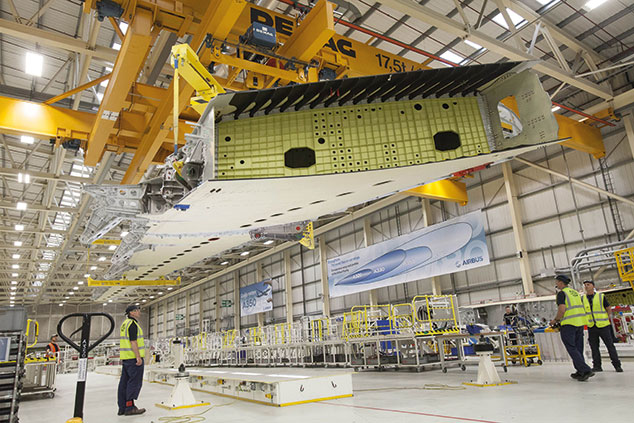
Sweden is well known for its engineering companies such as Atlas Copco, Saab, Sandvik, and Volvo. A more obscure Swedish name in this field is Hexagon AB (Stockholm: HEX AB), a precision-engineering and software company with a market value of €16bn. It combines sensors, satellite-based positioning technology and software to transform clients’ operations and improve their productivity.
For instance, Hexagon developed the first complete industrial assembly process based on laser measurements for the Airbus A380 programme. The system uses four Hexagon laser trackers (two for the wings and two for the fuselage), all connected to special control and measurement software. China HQC, meanwhile, used Hexagon to design the world’s largest indirect coal liquefaction project. This involved more than 13,000 pipelines and 2,400 pieces of equipment that had to withstand high temperatures and internal stress.
Hexagon has customers across a diverse range of industrial sectors, from agriculture and construction to manufacturing and mining. It invests a high 10%-12% of sales in research and development (R&D) to drive organic growth and also made ten small acquisitions during 2018. It is profitable with a very high operating margin of almost 25%, while sales have jumped by 50% in six years. Earnings per share have doubled over the same period.
A large global footprint
Hexagon has two divisions: Geospatial Enterprise Solutions (GES), accounting for 48.4%of sales, and Industrial Enterprise Solutions (IES) with 51.6%. Worldwide sales are evenly spread between the three main world regions: 34% go to the Americas, 38% to Europe, the Middle East & Africa and 28% to Asia (China 15%). Sales are spread over six main sectors, with surveying accounting for 21%, power, energy and mining 17%, electronics and manufacturing 17%, infrastructure and construction 14%, automotive 11%, and aerospace and defence 10%. The public safety sector comprises most of the remaining 10%.
This wide geographic and sectoral spread of sales ensures stable sales and earnings since a recession in one region or sector is compensated for by growth in another. In the fourth quarter of 2018 double-digit growth was recorded in Russia, Eastern Europe, South America, India and Japan while the Middle East contracted and Western Europe grew by 5%.
Hexagon introduced several new products last year, including an anti-jam antenna for offshore oil and gas platforms to nullify jamming and interference that can overpower satellite signals. Then there is a next-generation airborne mapping system, Leica TerrainMapper, used for forestry monitoring and infrastructure planning.
Going shopping
Hexagon has complemented its own product and technology range with takeovers. The ten acquisitions completed in 2018 included Nextsense of Austria, AutonomousStuff from America and Bricsys of Belgium. Nextsense specialises in non-contact profile measurement and surface inspection, while AutonomousStuff is a leading supplier of integrated autonomous vehicles to 2,500 customers worldwide.
Bricsys develops computer-aided design (CAD) software for collaborative building design. Bricsys adds to Hexagon’s existing structural and piping design range to enable the company to offer an end-to-end platform covering conceptual design, CAD, building information modelling, collaboration tools, project and cost controls, and progress documentation. In a full year Nextsense should add revenue of €16m, AutonomousStuff €51m and Bricsys €16m. All three are therefore small but important additions to Hexagon’s range of products.
A highly profitable performer
Hexagon’s 2018 revenue reached €3.76bn, with 8% organic growth at constant exchange rates. Earnings before interest aand tax (EBIT) were €929m, producing an excellent operating margin of 24.7%. The margin rose to 26% in the last quarter of 2018.
The balance sheet is in solid shape. Interest-bearing debt was €2.36bn with cash of €395m, giving net debt of €1.96bn or 2.5 times free cash flow of €789m. Net interest on debt was only €23m. A dividend of €0.59 was declared for 2018, giving a yield of 1.4% at the recent share price of €41.6.
Hexagon’s first-quarter results were announced on 7 May and showed sales growth of 10% from the first three months of 2018. Part of this growth came from acquisitions; organic growth hit 4%.
Overall growth would have been 17% had the safety & infrastructure arm of GES sold as much as last year rather than 17% less. Hexagon is taking action to stabilise the division in the second quarter and regain growth later this year to raise the overall organic growth rate substantially. Risks include the possibility that this could take longer than expected, while the US-China trade dispute could hamper growth.
Hexagon’s three acquisitions in the first quarter of 2019 were Thermopylae (mapping for US defence and intelligence customers), J5 (industrial operations management software) and Etalon (smart factory systems). These and other 2019 acquisitions will drive growth. New launches in the January-to-March period included products for mine operations management, testing and simulation of autonomous driving systems, and three-dimensional long range laser scanners. Analysts predict earnings per share (EPS) of SEK26.2 for 2020 (compared with SEK20.9 for 2018), giving a forward p/e of 16.8. Hexagon is a diversified digital engineering company with an excellent record.